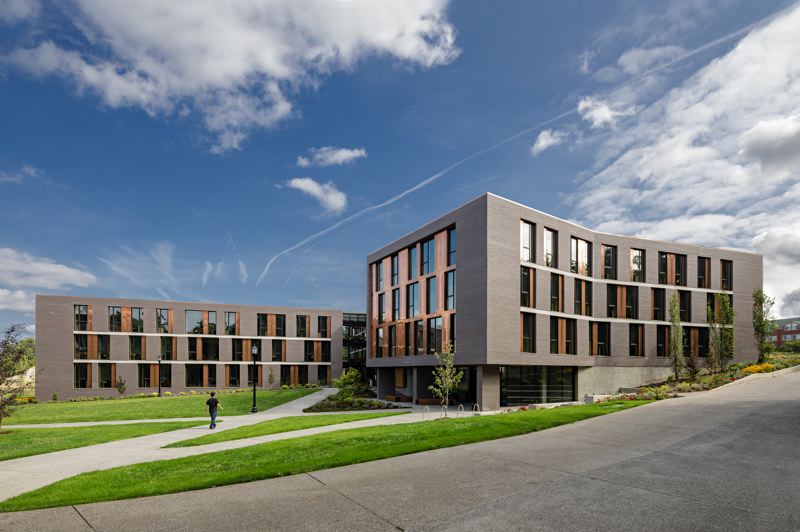Trillium Goes Platinum
New dorm earns top LEED rating for earth-friendly design.
Trillium, Reed’s new residence hall, has earned a LEED Platinum certification. Developed by the U.S. Green Building Council, LEED (Leadership in Energy and Environmental Design) is the most widely used green building system in the world, showcasing building that through design, construction, and operating practices make the world more sustainable and improve environmental health.
“LEED certification has become the goal for most modern construction projects,” said Steve Yeadon, director of facilities operations at Reed. “From the very beginning of the design process, it sets the stage for a sustainable building that carries through for the life of the building.”
Points are given in the areas of water efficiency, energy and atmosphere, materials and resources, indoor environmental quality, and sustainability. Out of 100 possible points, 40 points are required for LEED Certified status. 50 points will put a site on the Silver level; between 60 and 79 points earn Gold certification; and buildings that reach a minimum of 80 points are awarded Platinum status.
“The better the LEED rating, the better the foundation for a long-term building with minimal environmental impact, not only during construction, but over its lifetime,” Yeadon said.
Some of the features that earned Trillium its Platinum rating include:
- 89 percent of construction waste was diverted from landfill and recycled.
- Environmentally preferable and durable products were used throughout, including FSC-certified wood, products that were extracted, processed and manufactured locally, reclaimed products, and products containing recycled content.
- A photovoltaic array with panels that collect sunlight and convert it into direct current electricity.
- High thermal performance windows and walls that maximize thermal performance through compartmentalization and continuity. Resident rooms are supplied with ventilation air via heat recovery units that allow for heat to be recovered from restroom exhaust.
- Stormwater is captured on site to minimize the development impact. Site design reduces irrigation demand, and water efficient plumbing fixtures save 80 percent total building and site water.
- Operable windows that optimize daylight and provide access to views.
With 180 beds, three wings, and 60,000 square feet, Trillium is the largest building ever constructed by the college in a single phase. Each of the three wings contains three floors, housing 20 students per floor. The mix includes single rooms, traditional doubles, divided doubles, and a number of rooms specifically designed to be ADA accessible, including some with kitchenettes. In addition, each floor includes a kitchen, bathrooms, and a lounge. The central hub features a spacious, soaring common room and a terrace overlooking a new quadrangle. Designed by Braulio Baptista of ZGF Architects and built by Hoffman Construction, the dorm opened in fall 2019.
In the United States alone, buildings account for almost 40 percent of national C02 emissions. Buildings are responsible for enormous amounts of global energy use, resource consumption, and greenhouse gas emissions. Green buildings lower global carbon emissions, reduce electricity and water bills, and have a significant impact on personal health and well-being.
Tags: Awards & Achievements, Campus Life, Climate, Sustainability, Environmental, Institutional
